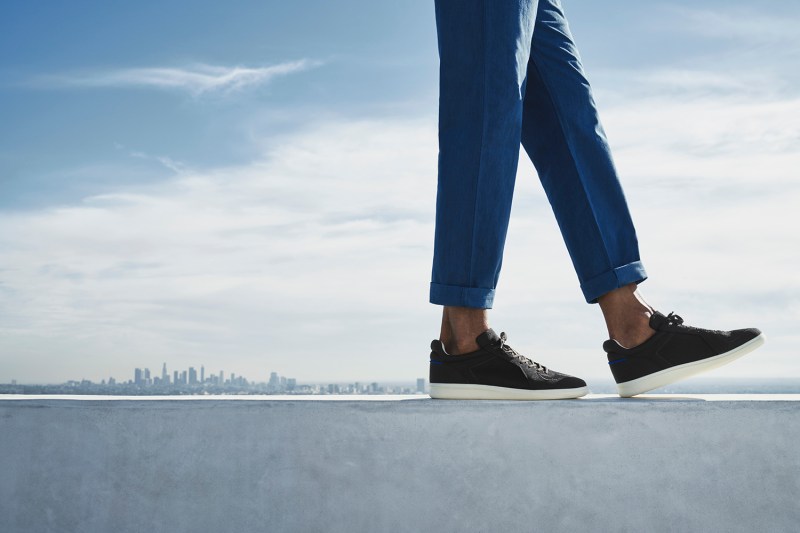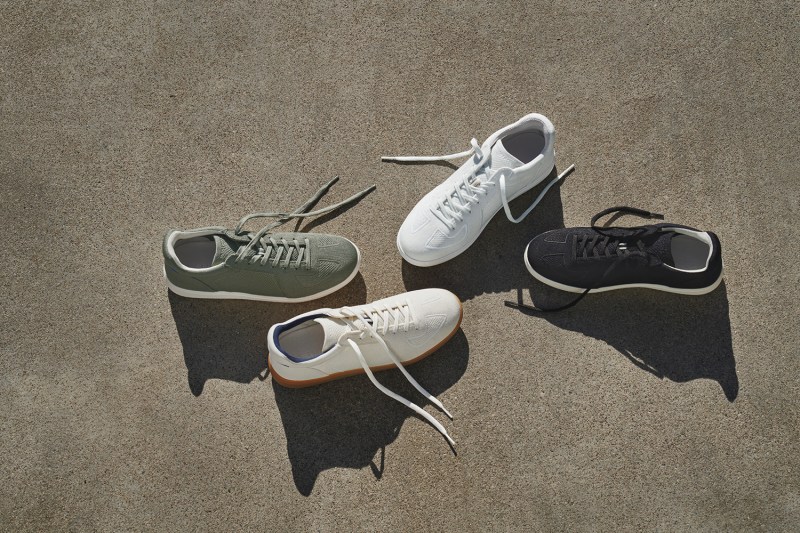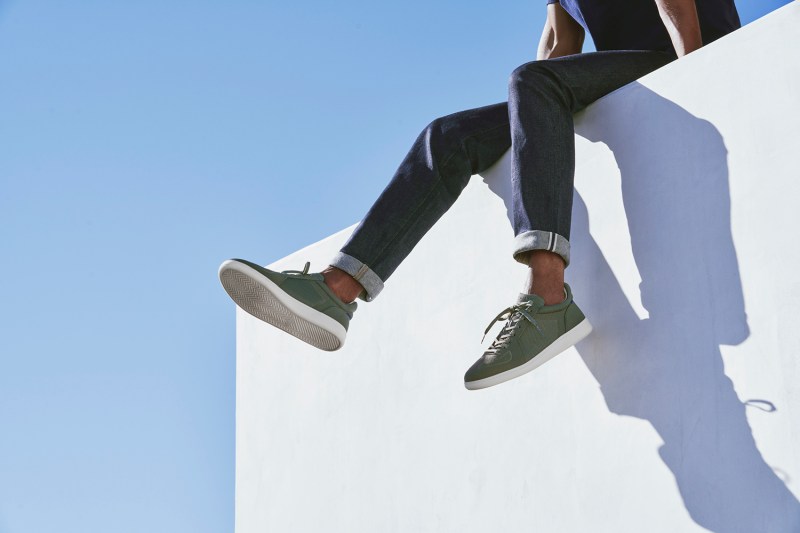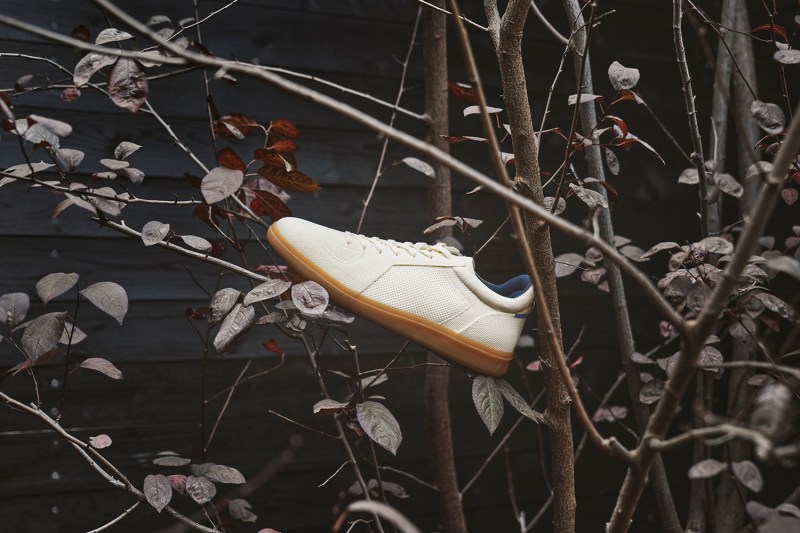
Lavion Gibson, director of product design for Rothy’s
Gibson, from his office in San Francisco and appearing onscreen with Senior Vice President of Men’s Chris Hull, 45, laughs at the memory. Hull laughs, too, as on Monday, May 20, the pair saw the company’s first two men’s shoes launch. The joke is, in part, the intensity that comes with core shoe culture. But the other part is that with its release, Rothy’s has allowed the fashion-forward man to have his cake and eat it, too. Phrased another way, the days of meticulous shoe care are a thing of the past, replaced with a regular washing machine and about an hour or two of time.
Rothy’s was launched in 2012 as the brainchild of Roth Martin and Stephen Hawthornthwaite, both successful in their respective fields of art and corporate business, who together conceived a fully formed plan on how to make women’s shoes better — but not in the way you might think. Instead of cutting the flats and loafers from traditional leather, their uppers were woven from a special fiber made from recycled plastic bottles. Besides the environmental benefit of reusing rather than crafting from virgin material, this decision carried numerous benefits. Weaving was as close to a zero-waste process as one might hope to achieve compared to the normal cut-and-sew assembly. Additionally, a literal rainbow of color and pattern options became available, while the finished product, with its soft interiors and minimal seams, provided a perfect out-of-the-box fit.
But maybe the biggest benefit was that it allowed the wearer to throw her shoes in the wash and, after a run through the gentle cycle, remove a pair of like-new kicks. Grunge, odors, and, yes, scuffs, were washed down the drain, ensuring that sought-after “crispy” look was possible in perpetuity.

While Rothy’s men’s line developers Hull and Gibson may seem like polar opposites — Hull wears glasses and swept salt-and-pepper hair with a sweater over a button-down, while Gibson wear a plain black tee with black beanie — the two have similar industry experience. Gibson spent nearly a decade as a senior designer for Teva, which had plenty of its own fashion collaborations for the non-Burning Man and Grizzly Man crowd, while Hull enjoyed stints with industry giant Nike and burgeoning newcomer Shinola. A men’s line had been in development since late 2019, but unsurprisingly, the coronavirus pandemic complicated much of its launch. With only one in-person meeting before lockdown, the pair accomplished it despite designing its debut styles remotely. (You think you’re tired of working from home? Try to conceptualize and execute a footwear style via Zoom and report back.)
Hull says its men’s line was “our most anticipated and requested launch since the launch of the brand itself” — but that doesn’t mean he and Gibson didn’t drive right for the green rather than laying up. Yes, the RS01
But what impressed this writer the most was its second style: the Driving Loafer
As its name suggests, the Loafer is patterned after the classic Italian driving loafer, a style that Hull and Gibson felt was both iconic and yet often overlooked. “I think people expect the Tod’s of the world [for a loafer], but they don’t expect any newness,” Gibson says. “A sneaker was necessary, but the boldness of a driving loafer gave us an opportunity to establish an identity early on.”

Hull agrees: “This is the one we’re most bullish on because this is all about respecting the past but representing the future,” he says.
You want to play jazz with style? Take it to another icon. The driving loafer requires adherence to a form, a sonnet of the shoe world, from the welt that encircles the forefoot to the nubbed outsole, which wraps up and over the heel and was developed to better feel the clutch as one shift gears. Even so, “We wanted to open up the aperture and make it more of a democratic style through comfort,” Hull says. “Democratic” is an understatement: While two of its four colorways are knitted in conservative navy and black solids, its other two are a green camouflage and a grey camouflage.
With so much riding on the men’s line, was it difficult to convince the founders to buy in to such a niche style? “It was an easier sell than you might imagine,” Gibson says. “We like to say from the pool party to the dinner party,” he continues, boasting of having worn the shoe “with everything from sweatpants to actual pants.”
The lunatics may be running the asylum, but Hull and Gibson seem to have just the right amount of crazy — and it’s spreading. The pair claim that in focus groups in Los Angeles and elsewhere, men have approached the shoe with a healthy skepticism but were quickly won over. “It’s not your father’s driving loafer,” Gibson says, its woven upper possibly making it the most comfortable driving loafer ever crafted.

“The world’s opening up again,” he says. “You can try something new.”
In the coming months, the brand will be pushing its initial-release shoe colors: four in each for the the Loafer and the RS01. But come autumn, Gibson and Hull have a few tricks up their sleeves. Without specifying, they point to the women’s line, which in the past has incorporated a seasonal merino-blended fiber for added warmth during the cooler months. Accessories, in which its women’s line has found success, are also in the works, though, again, specifics are scant. Hull hints at things “that carry money.”
“It’s still in the testing phase now,” he says. “We’ll see.”
But as we enter summer, a breathable, washable sneaker or driving loafer sounds especially seasonally appropriate. Gibson, who celebrated his marriage for the second time the weekend preceding his talk with The Manual, contrasts how he treated his white Rothy’s sneakers with those shoes of his youth. “We were moving stuff, loading cars. The sneakers are all scuffed up,” he says. “They’ll get thrown in the wash this evening and be as new as they were before launch.
“It’s a liberating experience to actually get to live in [them] without the burden of always trying to keep them clean,” he continues. “When you know you can just throw it in the wash, it allows you to live.”



